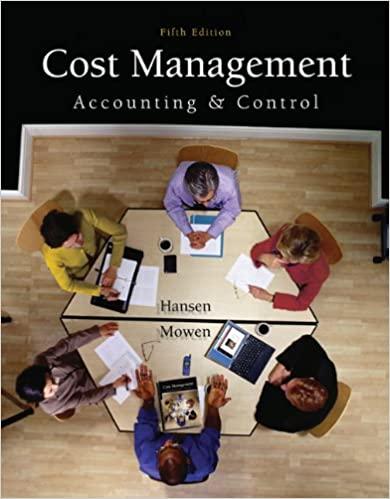Lynsar Corporation started as a single plant that produced the major components assembled into electric motorsthe companys
Question:
Lynsar Corporation started as a single plant that produced the major components assembled into electric motors—the company’s main product. Lynsar later expanded by developing outside markets for some of the components used in its motors. Eventually, Lynsar reorganized into four manufacturing divisions: Bearing, Casing, Switch, and Motor. Each of the four manufacturing divisions operates as an autonomous unit, and divisional performance is the basis for year-end bonuses.
Lynsar’s transfer pricing policy permits the manufacturing divisions to sell externally to outside customers as well as internally to the other divisions. The price for goods transferred between divisions is to be negotiated between the buying and selling divisions without any interference from top management.
Lynsar’s profits have dropped for the current year even though sales have increased, and the drop in profits can be traced almost entirely to the Motor Division. Jere Feldon, Lynsar’s chief financial officer, has discovered that the Motor Division has purchased switches for its motors from an outside supplier during the current year rather than buying them from the Switch Division. The Switch Division is at capacity and has refused to sell the switches to the Motor Division because it can sell them to outside customers at a price higher than the actual full (absorption) manufacturing cost that has always been negotiated in the past with the Motor Division. When the Motor Division refused to meet the price the Switch Division was receiving from its outside buyer, the Motor Division had to purchase the switches from an outside supplier at an even higher price.
Jere is reviewing Lynsar’s transfer pricing policy because he believes that suboptimization has occurred. While the Switch Division made the correct decision to maximize its divisional profit by not transferring the switches at actual full manufacturing cost, this decision was not necessarily in the best interest of Lynsar. The Motor Division paid more for the switches than the selling price the Switch Division charged its outside customers. The Motor Division has always been Lynsar’s largest division and has tended to dominate the smaller divisions. Jere has learned that the Casing and Bearing divisions are also resisting the Motor Division’s desires to continue using actual full manufacturing cost as the negotiated price.
Jere has requested that the corporate accounting department study alternative transfer pricing methods that would promote overall goal congruence, motivate divisional management performance, and optimize overall company performance. Three of the transfer pricing methods being considered are listed below. If one of these methods should be selected, it would be applied uniformly across all divisions.
a. Standard full manufacturing costs plus markup
b. Market selling price of the products being transferred
c. Outlay (out-of-pocket) costs incurred to the point of transfer plus opportunity cost per unit
Required:
Form a group of six students. First, brainstorm answers to the following three requirements.
Then, split your group into three pairs; each pair is responsible for writing up the answer to one of the requirements and turning it in as part of a group assignment for the following class period.
1.
a. Discuss both the positive and negative behavioral implications that can arise from employing a negotiated transfer pricing system for goods that are exchanged between divisions.
b. Explain the behavioral problems that can arise from using actual full (absorption)
manufacturing costs as a transfer price.
2. Discuss the behavioral problems that could arise if Lynsar Corporation decides to change from its current policy covering the transfer of goods between divisions to a revised transfer pricing policy that would apply uniformly to all divisions.
3. Discuss the likely behavior of both “buying” and “selling” divisional managers for each of the following transfer pricing methods being considered by Lynsar Corporation.
a. Standard full manufacturing costs plus markup
b. Market selling price of the products being transferred
c. Outlay (out-of-pocket) costs incurred to the point of transfer plus opportunity cost per unit.
Step by Step Answer:

Cost Management Accounting And Control
ISBN: 9780324233100
5th Edition
Authors: Don R. Hansen, Maryanne M. Mowen





